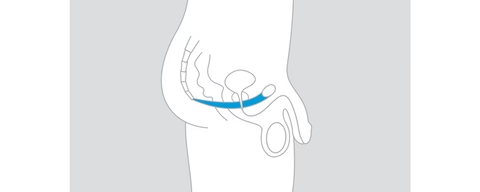Kegels For Men: Do They Really Work?
Published October 11, 2025

Pelvic floor fitness and Kegel exercises are perhaps more strongly associated with women's health than with men's health in the general public consciousness, but that is definitely a misconception. If you dig a little deeper, you’ll find that many guys swear by Kegels to help with a number of men’s health and wellness issues. But with claims floating around that they can help with sexual health and sexual performance (including erectile dysfunction, premature ejaculation, and better sex in general), prolapse, or bladder control/urination issues, it can seem like Kegels for men or pelvic floor fitness more generally must be too good to be true.
This article dives into pelvic floor exercise for men: what is it, why does it matter, what is the evidence that it can have benefits? In short, does pelvic floor exercise for men really work?
What is the pelvic floor?
In men, as in women, the pelvic floor is a kind of hammock of muscles, ligaments, nerves and connective tissue at the base of the pelvis (shown in blue in the diagram below).
It has a number of responsibilities in the male body. Some of the main ones include:
- Bladder control: help manage the flow of urine (and stool) by enabling control of the urethra and sphincter.
- Erectile function and stamina/control: the pelvic floor muscles have a key role in controlling blood flow to the penis, and research has found that they can have a significant effect on erectile function and sexual stamina.
- Musculoskeletal support: help keep your pelvic organs in the right place and help support your lower back and core.
Why Do Kegels Matter for Men?
The short answer is that pelvic floor dysfunction is both common and a huge quality-of-life driver. And as with any other problem that is both impactful and widespread, potential solutions are a big deal. More specifically:
- Premature ejaculation is estimated to afflict around 30% of men across all ages. Furthermore, for reasons including embarrassment and social taboos, “most sufferers do not seek assistance with their physician, and most of those who do are not satisfied with the results.”
- Erectile dysfunction is even more common, with studies having estimated prevalence in the US at around 50% for at least some degree of ED. And while it is more common as you get older, it is still not rare even in younger and middle aged men.
- Urinary incontinence (UI) is also shockingly common, with studies having found that over 70% of men will experience some variety (e.g. stress urinary incontinence, overactive bladder, or mixed) at some point during their life. Leakage problems also become much more widespread with age and are particularly relevant for those with prostate issues.
As with any muscles in the body, the pelvic floor muscles need to maintain a certain level of strength (and flexibility) to be able to do their jobs. And also as with all of your other muscles, they tend to get weak if they’re not exercised properly -- and that tendency only increases as you get older. But the good news is that a good exercise regimen for your pelvic floor is not very time-consuming (even if it becomes part of your daily routine), and can make a big difference. Regardless of whether you're looking at pelvic floor exercise from a preventative perspective or as a treatment for a problem that has already cropped up, it can be well worth it. Basically, if you take care of your pelvic floor muscles, they’ll generally take care of you.
What is the evidence for (or against) Kegels for men?
As mentioned above, there are a number of areas where pelvic floor health is relevant for men. But is there proof about whether pelvic floor exercise specifically can have beneficial effects in these areas? We'll turn to published literature for answers there and cite a few studies and conclusions below.
1. Can pelvic floor muscle exercise help with urinary incontinence in men?
Yes.
“Evidence suggests that pelvic floor muscle exercises are a realistic first-line conservative approach for the treatment of male urinary incontinence.” (Dorey 2003)
2. Can pelvic floor exercise help people with premature ejaculation / stamina difficulties?
Yes.
“[The authors] treated 40 men with lifelong premature ejaculation… at the end of a 12-week pelvic floor muscle rehabilitation, 82.5% of the 40 patients had gained control of their ejaculatory reflex.” (Pastore 2014)
3. Can pelvic floor muscle training lead to better sex for men without any kind of sexual dysfunction?
Yes.
A study in 2014 found that “this randomised controlled trial of active and resisted pelvic floor muscle training in men without ED… has demonstrated increased pelvic floor muscle strength, erectile rigidity and durability, ejaculation control and force. Additionally, sexual confidence and sexual pleasure were improved.” (Siegel 2014)
4. Can pelvic floor muscle exercise help with erectile dysfunction?
Yes.
“Pelvic floor muscle training appears effective in treating erectile dysfunction.” (Myers 2019)
5. Can pelvic floor exercise help with recovery from prostate surgery?
Yes.
“Prostate cancer is the most common cancer in men in the UK. Treatment with radical prostatectomy may produce risk factors that commonly include urinary incontinence and erectile dysfunction. Evidence has shown that these embarrassing conditions may be treated successfully with pre-operative and post-operative pelvic floor exercises.” (Dorey 2013)
How do men do Kegels?
The first step is to find/identify the right muscles, which can be tricky since you can’t really see them directly. There are a few ways to do this:
- Imagine you are urinating and think about how you would try to stop the flow of urine mid-stream (without using your hands!). Those muscles that you just tensed to stop peeing are your pelvic floor muscles, and you just did a pelvic floor muscle contraction. You can also imagine that you are trying to stop yourself from passing gas.
- Stand naked in front of a mirror. When you are correctly doing a pelvic floor muscle contraction, you should see your scrotum lift up and your penis draw inwards slightly and often lift like an elephant’s trunk.
Once you have identified the correct muscles and figured out how to activate them, you can start exercising. You should feel a ‘squeeze and lift’ sensation with each contraction. Specific exercise routines vary, but the general principle is to do repeated sets of muscle contractions (and holds). You can also use an exercise aid such as kGoal Boost, which can provide biofeedback to help identify the muscles and also guided (and tracked) pelvic floor-controlled games and workouts.
Are Kegels the only kind of pelvic floor exercise?
No.
Kegel exercise refers to strengthening exercises for your pelvic floor. These can be very helpful, but as with the other muscles in your body, strength is not the only important dimension in how well they can function. Mobility / elasticity is also critically important.
Accordingly, there are two general classes of pelvic floor muscle dysfunction: when the muscles are too weak and when they are too tense. Muscles that are too tense are called overactive, high-tone, or (historically, although less so now) hypertonic. Overactive pelvic floor muscles struggle to relax, lengthen and flex, and can cause pelvic pain or other kinds of pelvic floor dysfunction.
Pelvic floor strengthening exercises, such as Kegels, are generally not the right tool to deal with an overactive pelvic floor. If you’re not sure whether your pelvic floor might be overactive, getting advice from a pelvic floor physiotherapist, urologist, or other healthcare provider is a great way to find the right physical therapy or other health/fitness regimen for your body.
The pelvic floor trainer mentioned above (kGoal Boost) includes both strengthening and relaxation / down training exercises and can support an appropriate pelvic floor fitness routine regardless of whether you need strengthening, down training, or both.
Can you summarize the above for me?
Pelvic floor muscles have a surprisingly wide range of responsibilities in the male body, from bladder control to multiple aspects of sexual function. Research has found that doing pelvic floor muscle exercise can help your sex life and/or your bladder control. Pelvic floor exercise (whether strengthening or relaxation / down training exercises) can be a great first-line, minimal side-effect place to start for dealing with or preventing many types of pelvic floor dysfunction.












